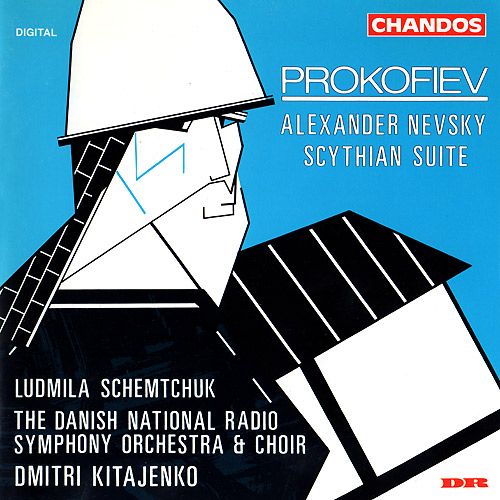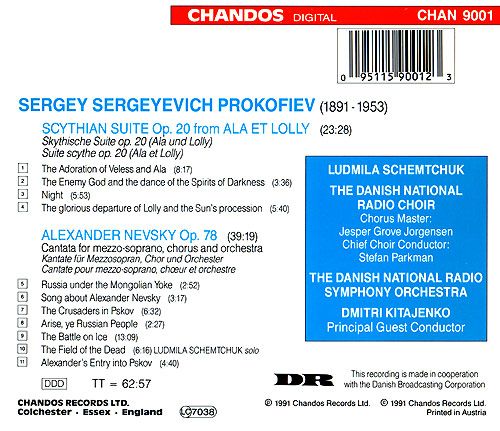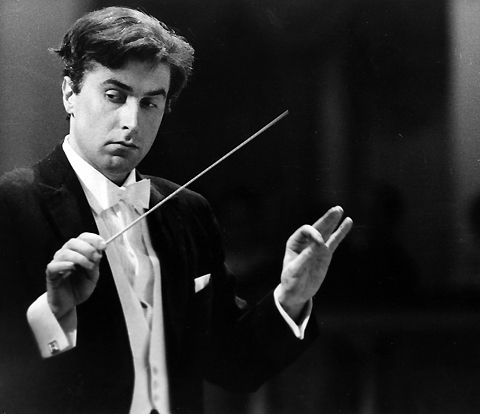wimpel69
11-28-2014, 06:10 PM
EAC-FLAC link below. This is my own rip. Complete artwork,
LOG and CUE files included. Do not share. Buy the original!
Please leave a "Like" or "Thank you" if you enjoyed this!
Another Nevsky! :)
Sergei Prokofiev and the celebrated film director, Sergei Eisenstein (1898-1948), managed to survive
the purges that decimated Russian intellectual life under Stalin. Together, they made two historically significant
films: Alexander Nevsky in 1938, and Ivan the Terrible, Parts 1 and 2 (No.3 never got beyond
preproduction). Worsening relations between Nazi Germany and the U.S.S.R. decided Stalin to sponsor a film
about Alexander Nevsky, a thirteenth century prince of Novgorod, who routed Swedish invaders in 1240 at the
river Neva (hence his name) and two years later defeated a horde of Teutonic Knights at Lake Chud (aka Peipus),
on what is today the Estonian border. Eisenstein offered to direct and persuaded Prokofiev to score the film.
Ironically, because Stalin and Hitler signed a nonaggression treaty before Nevsky was ready for release, it
was deep-sixed in the Soviet Union, although not elsewhere. Only after Hitler attacked the U.S.S.R. was
the film repatriated as a propaganda tool, by which time Prokofiev had reworked sections of his soundtrack
score into a "dramatic cantata" with texts by himself and V. Lugovskoy. Prokofiev conducted the Moscow
premiere on May 17, 1939.
In "Russia under the Mongolian yoke," high and low registers of the orchestra accompanied Eisenstein's
stark panoramas of bones, skulls, discarded weapons, wasted fields, and sacked villages in the wake of
marauding tartars; music at once eerie, archaic and despairing. The "Song about Alexander Nevsky" is
an uncomplicated telling of Prince Alexander's defeat of invading Swedes "on the wide waters of the
River Neva" in 1240, abetted by local peasants armed with axes and improvised weapons. A quicker
middle section (Pi� mosso) effectively recreates the sounds of battle. In "The Crusaders in Psko"
swaggering, scornful Teuton invaders sing Latin words not easy to translate, perhaps because
Prokofiev intended them to be onomatopoeic rather than narrative. An A minor middle section for
legato strings, which are asked to play "expressively and sadly," hardens before the Crusaders
quell a spirit of insurrection. "Arise, Russian people" exhorts them to defend, in the populist style
mastered by Prokofiev, plainly tuneful but nonetheless perfervid, with a new melody in the middle
section that returns triumphantly in the fifth and seventh movements. "The battle on the ice" is
the longest of the movements and stunningly graphic without needing film to be effective.
The Crusaders, shouting their Latin battle cry, ride wildly against Nevsky's force, who sing "In
our great native Russia no foe shall live...." The breakup of the ice is a terrifying sound, far
surpassing a small studio orchestra and constricted mono sound on the original soundtrack.
In "The field of the dead" the mezzo-soprano soloist becomes a Russian girl, looking for the body
of her lover slain in battle. She vows to kiss the eyelids of all who died, and to wed a "brave"
survivor rather than a "handsome man." A recapitulation of Russian themes celebrates
"Alexander's entry into Pskov" and rejoices in Nevsky's victory, as appropriate in World War II
and after as Stalin meant the film to be in 1937.
In the summer of 1914, Prokofiev, the then-emerging enfant terrible of Russian music, traveled
to London to meet with the ballet impresario Sergei Diaghilev. Diaghilev commissioned the young
composer to write a ballet with a prehistoric or fairy-tale scenario -- hoping, perhaps, for the
same kind of success he had recently enjoyed with the like-themed ballets of Stravinsky. Prokofiev
returned to St. Petersburg and engaged the services of poet Sergei Gorodetzky in developing an
effective story line. The composer settled on a theme centered on a prehistoric tribe of barbarians,
the Scythians, known to drink blood and engage in other similarly gruesome practices. The immediate
musical result was Ala and Lolli (1914-1915), which Prokofiev first presented to Diaghilev in
the form of a nearly complete piano score. Diaghilev, however, rejected the work as too close in spirit
to Stravinsky's Rite of Spring, fearing comparisons to the still-new succ�s du scandale. To
placate Prokofiev, Diaghilev commissioned from the dejected composer a new ballet, Chout (1915).
Before fulfulling that commission, though, Prokofiev turned his attention back to his orphaned ballet,
distilling its most effective numbers into the Scythian Suite.
The suite is cast in four movements whose titles readily evoke the ballet's prehistoric themes:
"The Adoration of Veles and Ala," "The Evil God and Dance of the Pagan Monster," "Night," and
"The Glorious Departure of Lolli and the Sun's Procession." What is most immediately striking
about the score is Prokofiev's brilliant orchestration. The music is the product of a 23 year old,
yet it clearly demonstrates the unmistakable confidence, control, and imagination of a seasoned
master. The vivid colors and instrumental effects are such that the work, despite its relative
unfamiliarity, survives as one of the most brilliant orchestral essays of its era.

Cover art from Chandos's mercifully brief cubist era.
Music Composed by
Sergei Prokofiev
Played by the
Danish National Radio Symphony Orchestra
With the
Danish National Radio Choir
And
Ludmila Schemtchuk (contralto)
Conducted by
Dmitri Kitajenko

"Dmitri Kitaenko is among the leading Russian conductors of his generation. Though generally overshadowed by
his contemporary Yuri Temirkanov, as well as older-generation figures like Kiril Kondrashin and Gennady
Rozhdestvensky, Kitaenko has held several prestigious conducting posts and has made a spate of critically
praised recordings for a variety of major labels in both operatic and symphonic repertory largely dominated
by Russian composers.
Kitaenko was born in Leningrad, on August 18, 1940. He studied conducting at the Leningrad Conservatory,
then later at the Moscow Conservatory under Lev Ginzburg. With the thaw in the Cold War allowing greater
artistic freedom in the Soviet Union, he moved onto the Vienna Conservatory where he studied under
famed conductor Hans Swarowsky.
The most crucial event in Kitaenko's early career was his entry in the first Herbert von Karajan Competition
in 1969, where he won first prize. The following year he was appointed artistic director at the Nemirovich-
Danchenko Music Theater in Moscow, a post that allowed him to gain much experience in operatic repertory.
He also began conducting the leading Russian orchestras and soon became a regular conductor at the
Bolshoi. He traveled abroad, too, leading important operatic productions in Brussels, Vienna, and Munich.
In 1976 he was appointed principal conductor of the Moscow Philharmonic Orchestra, succeeding Kiril
Kondrashin. During his 14-year stint in Moscow, Kitaenko made many recordings for the Soviet label
Melodiya, his releases including the complete symphonies of Prokofiev, and various works by Shostakovich,
Rachmaninov, and, surprisingly, Gershwin. In 1990 he left the Soviet Union for Western Europe, taking
two conducting posts concurrently, the Bergen (Norway) Philharmonic Orchestra, where he served until
1998, and the Hessischen Rundfunk Orchestra, Frankfurt, a post he held until 1996.
Among Kitaenko's first recordings to be released in the west was a 1991 Prokofiev disc on the Chandos
label containing Alexander Nevsky and the Scythian Suite, made with the Danish National Radio
Symphony Orchestra and Choir. After 1998, Kitaenko regularly began appearing as a guest conductor
in Europe, Japan, and the U.S. In the new century he has made a number of successful recordings,
including the 2001 cycle of the five Prokofiev piano concertos, with his former Frankfurt orchestra and
pianist Vladimir Krainev on the Elektra label. In 2005, Kitaenko finished recording the 15 symphonies
of Shostakovich, and the set was issued on the Capriccio label to a quite favorable critical response.
Further recordings included efforts on Shostakovich, Stravinsky, and Tchaikovsky."

Download Link - https://mega.co.nz/#!rVolFK5I!PoadAs1Dq4Sp6RsiAYfKxuFi4_GOzSvt2EVSdKd kAqQ
Source: Chandos Records CD, 1991 (my rip!)
Format: FLAC(RAR), DDD Stereo, Level: -5
File Size: 284 MB (incl. artwork, booklet, log & cue)
Enjoy! Don't share! Buy the origina! Please leave a "Like" or "Thank you" if you enjoyed this! :)
LOG and CUE files included. Do not share. Buy the original!
Please leave a "Like" or "Thank you" if you enjoyed this!
Another Nevsky! :)
Sergei Prokofiev and the celebrated film director, Sergei Eisenstein (1898-1948), managed to survive
the purges that decimated Russian intellectual life under Stalin. Together, they made two historically significant
films: Alexander Nevsky in 1938, and Ivan the Terrible, Parts 1 and 2 (No.3 never got beyond
preproduction). Worsening relations between Nazi Germany and the U.S.S.R. decided Stalin to sponsor a film
about Alexander Nevsky, a thirteenth century prince of Novgorod, who routed Swedish invaders in 1240 at the
river Neva (hence his name) and two years later defeated a horde of Teutonic Knights at Lake Chud (aka Peipus),
on what is today the Estonian border. Eisenstein offered to direct and persuaded Prokofiev to score the film.
Ironically, because Stalin and Hitler signed a nonaggression treaty before Nevsky was ready for release, it
was deep-sixed in the Soviet Union, although not elsewhere. Only after Hitler attacked the U.S.S.R. was
the film repatriated as a propaganda tool, by which time Prokofiev had reworked sections of his soundtrack
score into a "dramatic cantata" with texts by himself and V. Lugovskoy. Prokofiev conducted the Moscow
premiere on May 17, 1939.
In "Russia under the Mongolian yoke," high and low registers of the orchestra accompanied Eisenstein's
stark panoramas of bones, skulls, discarded weapons, wasted fields, and sacked villages in the wake of
marauding tartars; music at once eerie, archaic and despairing. The "Song about Alexander Nevsky" is
an uncomplicated telling of Prince Alexander's defeat of invading Swedes "on the wide waters of the
River Neva" in 1240, abetted by local peasants armed with axes and improvised weapons. A quicker
middle section (Pi� mosso) effectively recreates the sounds of battle. In "The Crusaders in Psko"
swaggering, scornful Teuton invaders sing Latin words not easy to translate, perhaps because
Prokofiev intended them to be onomatopoeic rather than narrative. An A minor middle section for
legato strings, which are asked to play "expressively and sadly," hardens before the Crusaders
quell a spirit of insurrection. "Arise, Russian people" exhorts them to defend, in the populist style
mastered by Prokofiev, plainly tuneful but nonetheless perfervid, with a new melody in the middle
section that returns triumphantly in the fifth and seventh movements. "The battle on the ice" is
the longest of the movements and stunningly graphic without needing film to be effective.
The Crusaders, shouting their Latin battle cry, ride wildly against Nevsky's force, who sing "In
our great native Russia no foe shall live...." The breakup of the ice is a terrifying sound, far
surpassing a small studio orchestra and constricted mono sound on the original soundtrack.
In "The field of the dead" the mezzo-soprano soloist becomes a Russian girl, looking for the body
of her lover slain in battle. She vows to kiss the eyelids of all who died, and to wed a "brave"
survivor rather than a "handsome man." A recapitulation of Russian themes celebrates
"Alexander's entry into Pskov" and rejoices in Nevsky's victory, as appropriate in World War II
and after as Stalin meant the film to be in 1937.
In the summer of 1914, Prokofiev, the then-emerging enfant terrible of Russian music, traveled
to London to meet with the ballet impresario Sergei Diaghilev. Diaghilev commissioned the young
composer to write a ballet with a prehistoric or fairy-tale scenario -- hoping, perhaps, for the
same kind of success he had recently enjoyed with the like-themed ballets of Stravinsky. Prokofiev
returned to St. Petersburg and engaged the services of poet Sergei Gorodetzky in developing an
effective story line. The composer settled on a theme centered on a prehistoric tribe of barbarians,
the Scythians, known to drink blood and engage in other similarly gruesome practices. The immediate
musical result was Ala and Lolli (1914-1915), which Prokofiev first presented to Diaghilev in
the form of a nearly complete piano score. Diaghilev, however, rejected the work as too close in spirit
to Stravinsky's Rite of Spring, fearing comparisons to the still-new succ�s du scandale. To
placate Prokofiev, Diaghilev commissioned from the dejected composer a new ballet, Chout (1915).
Before fulfulling that commission, though, Prokofiev turned his attention back to his orphaned ballet,
distilling its most effective numbers into the Scythian Suite.
The suite is cast in four movements whose titles readily evoke the ballet's prehistoric themes:
"The Adoration of Veles and Ala," "The Evil God and Dance of the Pagan Monster," "Night," and
"The Glorious Departure of Lolli and the Sun's Procession." What is most immediately striking
about the score is Prokofiev's brilliant orchestration. The music is the product of a 23 year old,
yet it clearly demonstrates the unmistakable confidence, control, and imagination of a seasoned
master. The vivid colors and instrumental effects are such that the work, despite its relative
unfamiliarity, survives as one of the most brilliant orchestral essays of its era.

Cover art from Chandos's mercifully brief cubist era.
Music Composed by
Sergei Prokofiev
Played by the
Danish National Radio Symphony Orchestra
With the
Danish National Radio Choir
And
Ludmila Schemtchuk (contralto)
Conducted by
Dmitri Kitajenko

"Dmitri Kitaenko is among the leading Russian conductors of his generation. Though generally overshadowed by
his contemporary Yuri Temirkanov, as well as older-generation figures like Kiril Kondrashin and Gennady
Rozhdestvensky, Kitaenko has held several prestigious conducting posts and has made a spate of critically
praised recordings for a variety of major labels in both operatic and symphonic repertory largely dominated
by Russian composers.
Kitaenko was born in Leningrad, on August 18, 1940. He studied conducting at the Leningrad Conservatory,
then later at the Moscow Conservatory under Lev Ginzburg. With the thaw in the Cold War allowing greater
artistic freedom in the Soviet Union, he moved onto the Vienna Conservatory where he studied under
famed conductor Hans Swarowsky.
The most crucial event in Kitaenko's early career was his entry in the first Herbert von Karajan Competition
in 1969, where he won first prize. The following year he was appointed artistic director at the Nemirovich-
Danchenko Music Theater in Moscow, a post that allowed him to gain much experience in operatic repertory.
He also began conducting the leading Russian orchestras and soon became a regular conductor at the
Bolshoi. He traveled abroad, too, leading important operatic productions in Brussels, Vienna, and Munich.
In 1976 he was appointed principal conductor of the Moscow Philharmonic Orchestra, succeeding Kiril
Kondrashin. During his 14-year stint in Moscow, Kitaenko made many recordings for the Soviet label
Melodiya, his releases including the complete symphonies of Prokofiev, and various works by Shostakovich,
Rachmaninov, and, surprisingly, Gershwin. In 1990 he left the Soviet Union for Western Europe, taking
two conducting posts concurrently, the Bergen (Norway) Philharmonic Orchestra, where he served until
1998, and the Hessischen Rundfunk Orchestra, Frankfurt, a post he held until 1996.
Among Kitaenko's first recordings to be released in the west was a 1991 Prokofiev disc on the Chandos
label containing Alexander Nevsky and the Scythian Suite, made with the Danish National Radio
Symphony Orchestra and Choir. After 1998, Kitaenko regularly began appearing as a guest conductor
in Europe, Japan, and the U.S. In the new century he has made a number of successful recordings,
including the 2001 cycle of the five Prokofiev piano concertos, with his former Frankfurt orchestra and
pianist Vladimir Krainev on the Elektra label. In 2005, Kitaenko finished recording the 15 symphonies
of Shostakovich, and the set was issued on the Capriccio label to a quite favorable critical response.
Further recordings included efforts on Shostakovich, Stravinsky, and Tchaikovsky."

Download Link - https://mega.co.nz/#!rVolFK5I!PoadAs1Dq4Sp6RsiAYfKxuFi4_GOzSvt2EVSdKd kAqQ
Source: Chandos Records CD, 1991 (my rip!)
Format: FLAC(RAR), DDD Stereo, Level: -5
File Size: 284 MB (incl. artwork, booklet, log & cue)
Enjoy! Don't share! Buy the origina! Please leave a "Like" or "Thank you" if you enjoyed this! :)